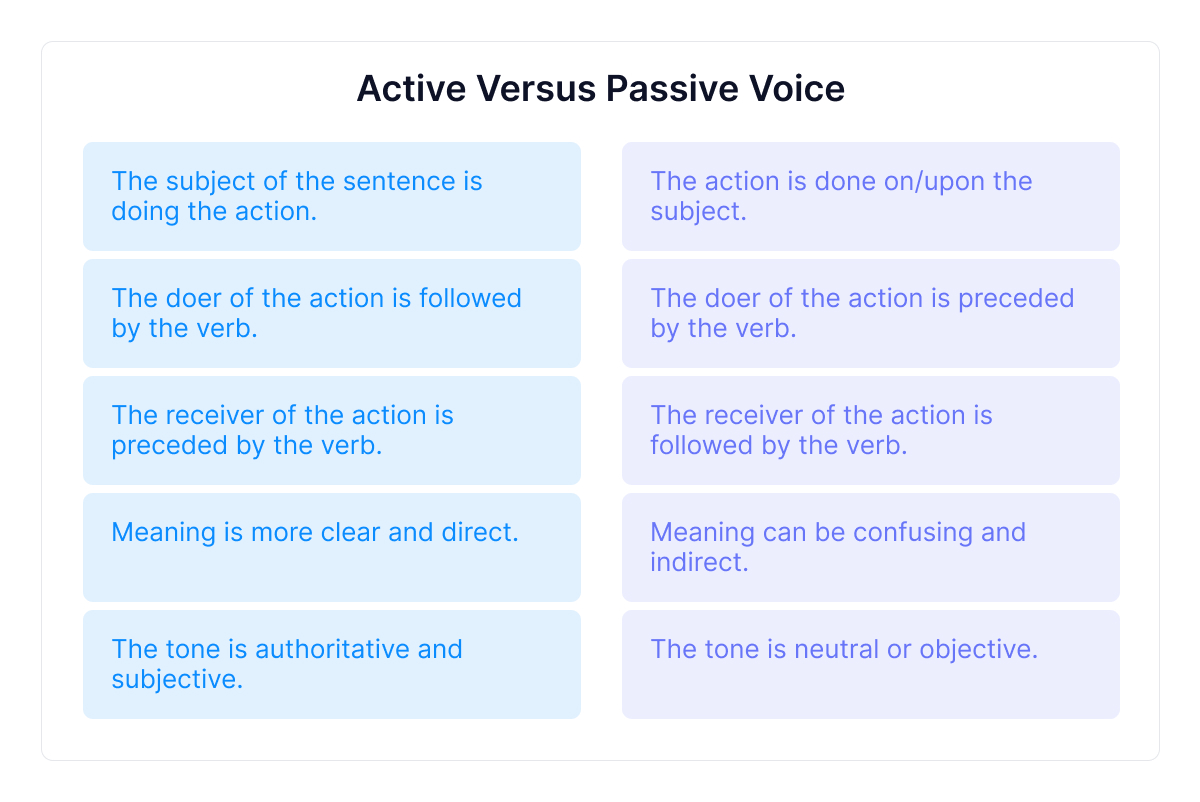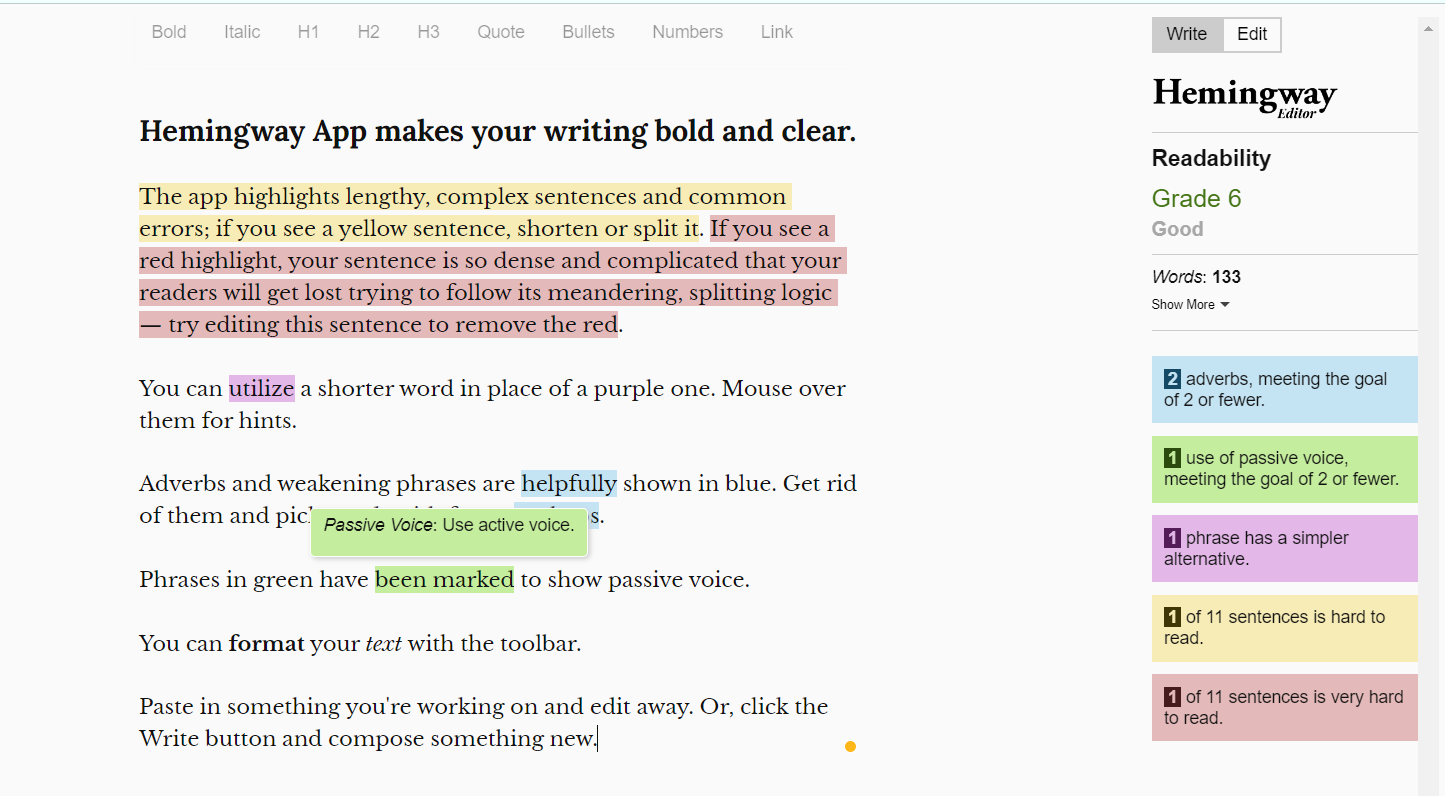If you are reading this, you probably often lean on using passive voice when writing your content.
You think it is a great way to emphasize the object and a part of your writing style.
Still, most of your sentences are less engaging and drive your visitors away.
Did you know that hundreds of sources say you should use passive voice below 10% for your blog posts?
If you’re already written a lot of sentences and you are not sure how to structure them into active voice, we got your back.
Today we will talk about three ways to rewrite a sentence into an active voice and make it more engaging for your audience.
Let’s begin!
Passive vs. Active voice, which one is better for content?
First, we need to know the difference between active and passive voice.
In a sentence written in the active voice, the subject of a sentence performs an action.
On the other hand, in a sentence written in the passive voice, the subject receives the action.
Active voice is usually preferred and more direct.
Passive voice is sometimes used to sound more formal or objective.
Active voice emphasizes the doer of an action, while passive voice emphasizes the object being acted upon.

Here are some marketing examples of passive vs. active voice use to help you make a difference:

In the picture above, you can notice:
- The sentence in the passive voice has more words than the active one
- The sentence in the passive voice focuses on the action, while the active one focuses on the subject
- The sentence in the passive voice has a more pushy tone, while the active one has a natural flow and tone
If you want to make engaging content for your readers, it is very important for your texts to be concise and have a natural flow. You can achieve that by using an active voice when writing content.
This is not the only thing you should remember if you are a content creator.
There are many more tips for effective storytelling and creating engaging content, but providing mostly active voice will make your content more engaging.

Knowing the difference between active and passive voice will give you insight into how and when to use them. First, let’s see why an active voice is better for your content:
Why is active voice better for content writing?
There are different benefits of using active voice in your content:
- Active voice sentences are shorter, and online readers prefer short sentences.
- When you use the active voice, you make clear who is performing the action in a sentence, making your content more readable.
- With an active voice, your sentences have more impact and are more direct, telling the reader what’s going on without any confusion.
- Sentences in active voice are more engaging because they get to the point faster and easier.
- After using an active voice, your content feels more “ human” and “ natural” to readers.
On the other hand, there are 5 issues with using passive voice:
- Reduces precision - Your readers are not sure what is going on.
- Reduces clarity - It is unclear who is doing the action, so your readers can be confused.
- Reduces accountability of the writer- Your readers feel like you are not giving your opinion.
- Offers a false sense of objectivity- Your readers want to feel like you are telling the story, and passive doesn’t help you with that.
- Dehumanises your content - Your content feels too generic and objective, so readers can’t connect to it.

Now that you know the issues in using passive voice for your content, you can avoid them. Still, what if you had already written a sentence in passive voice? Here is how to fix it.
3 Ways to rewrite a sentence into active voice
1. The classic way - find the subject
The old-school way is to turn the sentence into an active voice.
Here is a quick grammar lesson that will show you how to rewrite a sentence into active voice:
1. To change passive sentences to active, first find out who or what is performing the action expressed in the verb.
That will become your new subject.
Example: Our content is written by proficient content writers.
Here the action is performed by "proficient content writers," so that will become the subject and the first word in the active sentence.
2. Find the object of the active sentence, which is the subject in the passive sentence
Example: Our content is written by proficient content writers.
Here the subject/active object is "our content."
3. Then convert any "to be" verb into its active equivalent
Example: Content is written by proficient content writers.
The verb "to be "here is "is written," and the active equivalent is "write."
4. Delete unnecessary words such as "by".
So, the active sentence is: Proficient content writers write our content.
In its original form, this sentence is too wordy and emphasizes what's happening to the data.
It would flow better if we changed it to the active voice and omitted unnecessary details.
Here is another example of the elements in the passive/active sentence:

Are you unsure how or don’t want to check your text for passive voice sentences? There is a free/easy way to do it. Just keep reading.
2. Use Hemingway to spot the passive voice sentence
If you have difficulty spotting sentences in passive voice, Hemingway will spot the passive sentences for you. This will make your job much quicker and easier, so let’s learn more about it.
Hemingway App is a free online tool that can help you out with your writing.
One of its features is spotting passive sentences. You paste/write your text, which will instantly show you a message about passive voice usage.
Unfortunately, Hemingway can’t help you rewrite them, so you will have to do it independently.
Still, it is a great tool if you missed spotting some passive voice sentences in your text. So let’s see it in action:

As you see, the passive voice sentences are marked with green. On the right side, you can see the green tab, which says how many uses of passive voice are in your text.
When you notice the passive sentence, you can go back to the first step and change it into an active sentence.
3. Use Grammarly to change your sentence into an active voice
Grammarly is another online tool that can help you change your sentences into an active voice. There is a free version that you can download and use as a Chrome Extension.
Here is how it works:

You write a sentence in the passive voice. Then, on the right side, Grammarly leaves you a suggestion to rewrite it in active voice.

When you click on the suggestion, you will get a note and a button that says, “ Rewrite in active voice.”
After you click on the button, Grammarly rewrites your sentence. Here is the result:

Pretty easy, right?
Yet, the downside is that Grammarly doesn’t always change the passive voice. Here is an example:

As you see, the sentence is in passive voice, and Grammarly didn’t leave a note.
This is because sometimes Grammarly thinks passive voice is a part of your style and doesn’t ask you to rewrite it.
This can be misleading because you want most of your sentences to be in an active voice.
But there is a solution for it.
Rewrite Sentences Into Active Voice Using TextCortex
Rewriting your sentences into an active voice will make your content: clear, short, and engaging.
These 3 things are essential if you want your audience to read your content from start to finish.
If your audience sees that you use sentences they don’t use in their everyday lives, they won’t read it.
Do you want to know the easiest way to make active sentences that will please your audience?
Let Text Cortex do the work for you.
TextCortex is an AI copywriting tool that helps you create content by expanding your ideas, rewriting sentences, and generating an email from the bullet points—all in one place.
The best thing about TextCortex is that it can rewrite your passive sentence into an active one in a few seconds.
Here is how it works:
1. You type or paste your text and click on the TextCortex icon, which will give you a couple of options below.
Using TextCortex, you don’t even need to think about the classic way of rewriting a sentence into active voice.
Some other benefits of Text Cortex are:
- It gives you many options for rewriting your sentences
- Always offers suggestions for passive sentences
- It makes your sentences sound more natural
- Finds the right words
- Uses clear and conscious sentences
TextCortex helps you get your idea across fast and make sense of the trends you need to follow.
Download the Text Cortex Chrome Extension, rewrite passive voice sentences into active ones, and create a different type of content in seconds.
.jpg)



.png)

